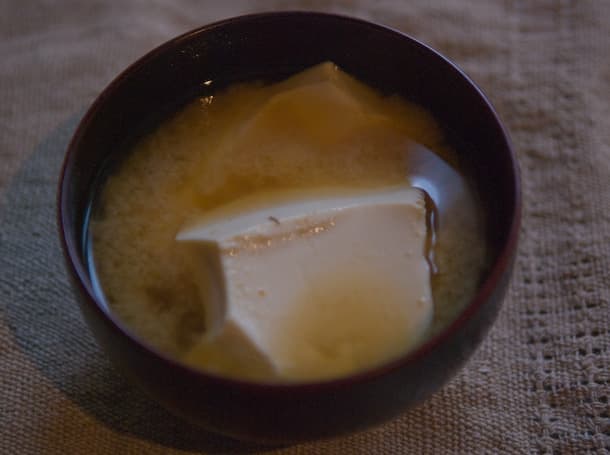
Konbu-Kasuobushi Dashi & Silken Tofu Miso Soup
Learn how to make konbu-katsuobushi dashi and a delicious miso soup using traditional Japanese cooking techniques. This article guides you through the process of preparing dashi, talks about the crucial role of water in konbu boiling, and provides step-by-step instructions for crafting a flavorful miso soup. Explore the art of Japanese cuisine and bring authentic flavors to your home kitchen!
Let's talk about how to make a dashi before we get to this simple, delicious soup. Everything I've read about preparing konbu-katsuobushi dashi (kelp and dried, shaved bonito) says to first add the konbu to a pot of water and bring it to just a boil, then to remove the konbu before the water starts to really boil. My friend Chef Atsushi Nakahigashi took a totally different approach.
First, Atsushi soaked a six-inch piece of konbu overnight in a pot of about two cups of water. Then, he brought the water up to a boil over medium heat -- and kept boiling with the konbu inside. He told me that he spoke to his father about preparing dashi here in New York, and his father advised to boil the konbu because our water is much harder than in Kyoto (harder meaning containing more minerals).
Atsushi fanned the aroma of the liquid to his nose as he watched the konbu boil, and tasted the liquid. He explained that when white bubbles appear on the surface of the liquid and you can really sense the fragrance of the konbu, it's ready. At this point, he turned off the heat and removed the konbu, after about five minutes of boiling.
Now Atsushi waited for the liquid to cool. Technically the liquid should cool to 80-degrees Celsius (176-degrees Fahrenheit) before adding the katsuobushi, he said. After a couple of minutes, he estimated that the water cooled sufficiently, and added a handful of katusobushi. He tasted the liquid, and added another handful. Remember, the liquid is not being heated at this point. After a few minutes, the liquid developed a rich katsuobushi taste and aroma. The dashi was ready. At this point, Atsushi strained the liquid through a sieve lined with a sarashi, a thin cheesecloth-like piece of cotton fabric (cheesecloth will work, too).
Preparing dashi in this manner is clearly a game of finesse. All I can suggest is to practice making it and taste, practice making it and taste. At one point as we were cooking, Atsushi turned to me and said, "I want to bring you to my father's restaurant again to taste real dashi." Atsushi's on to something. If there's a Japanese restaurant that you particularly love, why not ask the chef if you can try his or her dashi? That'll give you a flavor baseline you can use to get your own dashi down.
Once you've strained the liquid, you can use the cooked katsuobushi to prepare niban dashi, or "second dashi." (You don't reuse the konbu.) Place the katsuobushi and two cups of water in a pot and bring to a boil. When the liquid is boiling, add another handful of fresh katsuobushi (called oigatsuo, if I got it right -- "chaser katsuo"). Now turn off the heat and after about five minutes, strain the liquid through a sarashi.
Okay, on to the miso soup!
Silken Tofu Miso Soup
Ingredients:
- 2 cups dashi
- Miso (about 2 tablespoons, or to taste)
- 1 cake silken tofu
Instructions:
-
Heat the Dashi: In a pot, bring the dashi to a boil and then turn off the heat.
-
Dissolve the Miso: Using a special miso strainer, dissolve about two tablespoons of miso into the dashi. Adjust the amount based on the type and saltiness of the miso used. The broth should taste strong, as the tofu will balance it out with its water content.
-
Add the Tofu: Add an entire cake of silken tofu to the broth. Break it into chunks if desired.
-
Boil the Broth: Turn up the heat and bring the broth to a boil. Let it boil for a few minutes to allow some of the water from the tofu to evaporate, concentrating the flavors.
-
Serve: Carefully scoop chunks of tofu into bowls and pour the hot broth over them.
Techniques and Their Purposes:
Dissolving Miso with a Strainer:
Using a miso strainer helps ensure that the miso is fully dissolved into the dashi without leaving clumps. This technique creates a smooth, evenly flavored broth. The strainer also allows for easier adjustment of the miso concentration in the soup.
Adjusting Broth Strength:
The broth is made stronger than typical miso soup to compensate for the water content in silken tofu, which dilutes the broth's flavor. This ensures that the final soup has a balanced taste, highlighting both the savory depth of the miso and the delicate sweetness of the tofu.
Boiling with Tofu:
While boiling miso is generally avoided to preserve its probiotic benefits, in this recipe, the boil serves to reduce the water introduced by the tofu, concentrating the flavors for a richer broth. This step is crucial for achieving the right balance between the broth's savoriness and the tofu's mildness.
